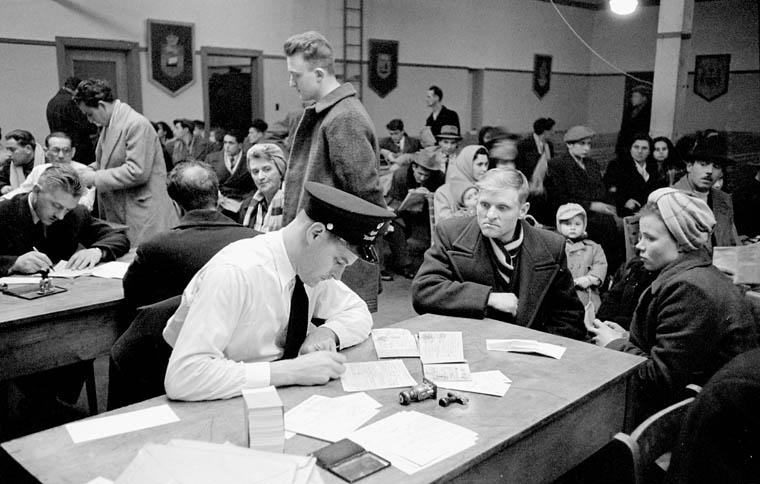The Postwar Immigrant Wave
A new stream of war-ravaged Europeans once again shakes up Canada's demographics
Date: 1950
The Second World War left a scar across much of Europe. Air raids had turned cities into skeletons; clashes had transformed countrysides into mass graves. Even the continent’s map had become a wartime casualty, as new international borders divvied up former nations. By war’s end, masses of people returned to find their homes destroyed or their countries subsumed by foreign regimes. Over a million would flee as refugees, seeking shelter elsewhere — including Canada.
Before the 1940s, the bulk of immigrants came to Canada desperate for economic opportunity. But these postwar newcomers, many with advanced educations, were different. They wanted religious and political freedom; they wanted stability. The federal government responded to this new wave by adjusting its immigration laws. By 1946, Canadian residents could sponsor close relatives. Soon, Canada would send teams to European refugee camps to identify migrants deemed “acceptable,” which sometimes excluded people with severe physical disabilities.
This would only be the start. Canada’s peacetime economy was booming and in need of more workers. Still, the country would spend the next several years trying to determine who, exactly, made for the ideal immigrant — and how to codify its preferences into law. Eventually, a hierarchy based on nationality and ethnicity took shape with preference given to immigrants from places like Britain and the Netherlands. Within two years, 16,000 Dutch farmers had come to Canada. Those who settled in B.C. often started new farms in the Fraser Valley.
By 1947, the Cold War had begun, and Canadian immigration policy would change yet again to reflect the country's new geopolitical priorities. Now, the greatest number of immigrants came from Poland. They were accompanied by their neighbours from Central Europe and the Baltic states, whose homes were now under the thumb of the Soviet Union.
Then came Mediterranean emigrants, following more changes to the rulebook. In 1950, Canada announced it would welcome “any healthy applicant of good character who had skills needed in Canada and who could easily integrate into Canadian society.” Seventeen thousand Portuguese immigrants would arrive that decade, largely through contracts to work on farms and railroads. At the same time, hundreds of thousands of Italians made their way over via chain migration, often congregating in Canada’s larger cities. Many put down roots in East Vancouver.
About 40,000 Jewish survivors of the Holocaust came to Canada, too, a sharp contrast from only years before. In the 1930s, Canada had turned away many fleeing Nazi persecution — a product of the antisemitism that then coloured Canadian immigration policy and broader society, in general. Decades later, the number of Jews who either survived the Holocaust or whose ancestors had was five times higher in Canada than in the United States; in 1990, that figure stood at approximately 40 per cent and eight per cent, respectively.
While immigrants settled across Canada, many did make their way out west to British Columbia. From 1951 to 1961, the province’s population grew by 464,000 to 1.6 million people. Over half of this growth came from net migration alone. Bringing their own unique cultures with them, this influx of emigrants would add new character to towns across B.C.
Sources:
1. Belshaw, John Douglas. “Post-War Immigration.” Canadian History: Post-Confederation, BC Open Textbook Project, 17 May 2016, opentextbc.ca/postconfederation/chapter/5-11-post-war-immigration/.
2. Belshaw, John Douglas. Becoming British Columbia: A Population History. UBC Press, www.ubcpress.ca/becoming-british-columbia.
3. Dench, Janet. A Hundred Years of Immigration to Canada 1900 - 1999 (Part 2). Canadian Council for Refugees, ccrweb.ca/en/hundred-years-immigration-canada-part-2.
4. Ginn, Edith Margaret. Rural Dutch Immigrants in the Lower Fraser Valley. University of British Columbia, May 1967, open.library.ubc.ca/cIRcle/collections/ubctheses/831/items/1.0104710.
5. Nationalism, Late 1800s–1950s: Canadian Immigration and War. CanLit Guides, 9 Aug. 2013, canlitguides.ca/canlit-guides-editorial-team/nationalism-late-1800s-1950s-canadian-immigration-and-war/.
6. Polish Immigrants. Library and Archives Canada, www.bac-lac.gc.ca/eng/discover/immigration/history-ethnic-cultural/Pages/polish.aspx.
7. “The Portuguese in Canada.” The Portuguese in Canada | Pier 21, Canadian Museum of Immigration at Pier 21, pier21.ca/research/pier-21/the-portuguese-in-canada.
8. Schoenfeld, Stuart. “Jewish Canadians.” The Canadian Encyclopedia, 3 Mar. 2012, www.thecanadianencyclopedia.ca/en/article/jewish-canadians.






